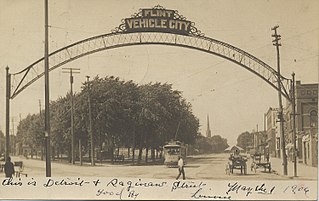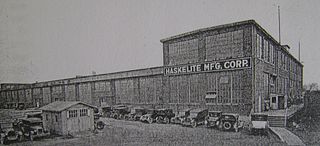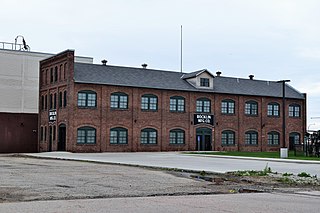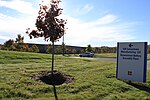Related Research Articles

Hupmobile was an automobile built from 1909 through 1939 by the Hupp Motor Car Company of Detroit. The prototype was developed in 1908.

The Highland Park Ford Plant is a former Ford Motor Company factory located at 91 Manchester Avenue in Highland Park, Michigan. It was the second American production facility for the Model T automobile and the first factory in history to assemble cars on a moving assembly line. It became a National Historic Landmark in 1978.

Willow Run, also known as Air Force Plant 31, was a manufacturing complex in Michigan, United States, located between Ypsilanti Township and Belleville, constructed by the Ford Motor Company for the mass production of aircraft, especially the B-24 Liberator heavy bomber. Construction of the Willow Run Bomber Plant began in 1940 and was completed in 1942.

Fisher Body was an automobile coachbuilder founded by the Fisher brothers in 1908 in Detroit, Michigan. A division of General Motors for many years, in 1984 it was dissolved to form other General Motors divisions. Fisher & Company continues to use the name. The name and its iconic "Body by Fisher" logo were well known to the public, as General Motors vehicles displayed a "Body by Fisher" emblem on their door sill plates until the mid-1990s.

Fleetwood Metal Body was an automobile coachbuilder formed on April 1, 1909. The company name was derived from Fleetwood, Pennsylvania, home of the company at the start, and lived on for decades in the form of the Cadillac Fleetwood and various Fleetwood trim lines on Cadillac cars. As of 2022, the remaining original buildings of Fleetwood Metal Body are undergoing restoration and renovation into loft-style apartments.
Buick City was a name applied to the former Buick home plant following major renovations completed during the early 1980s to better compete with Japanese producers. The plant was a massive automobile manufacturing complex in the northeast of Flint, Michigan. Elements of the 235-acre (950,000 m2) complex dated from before 1904, when it was known as Flint Wagon Works. Once General Motors assumed operations all aspects of Buick vehicles were constructed, and it became known as "Buick City" in 1985. The engine block and cylinder heads were cast at Defiance Foundry in Defiance, Ohio and earlier at Saginaw Metal Casting Operations in Saginaw, Michigan.

Willow Run Assembly was a General Motors automobile factory near Ypsilanti, Michigan, located at 2625 Tyler Road, in the Willow Run manufacturing complex. Willow Run Assembly consisted of an assembly plant of 2.3 million square feet, another building that was known in later years as "Willow Run Company Vehicle Operations", covering 23,000 square feet on 22 acres of land, and perhaps other parcels. Willow Run Assembly was to the south of the former Willow Run Transmission, the site of the bomber plant built by Ford in 1941.

Detroit Arsenal (DTA), formerly Detroit Arsenal Tank Plant (DATP) was the first manufacturing plant ever built for the mass production of tanks in the United States. Established in 1940 under Chrysler, the plant was owned by the U.S. government until 1996. It was designed by architect Albert Kahn. The building was designed originally as a "dual production facility", so that it could make armaments and be turned into peaceful production at war's end. Notwithstanding its name, the 113-acre (0.46 km2) site was located in Warren, Michigan, Detroit's most populous suburb.

The Packard Proving Grounds, was a proving ground established in Shelby Charter Township, Michigan in 1927 by the Packard Motor Car Company of Detroit. It is listed in the National Register of Historic Places.

Flint, Michigan is a city which previously relied on its automotive industry, and still does to an extent. Over the past several decades, General Motors plants in Genesee County have experienced re-namings, management shifts, openings, closures, reopenings, and spinoffs.
The United States Army DEVCOM Ground Vehicle Systems Center (GVSC), located in Warren, Michigan, is the United States Armed Forces' research and development facility for advanced technology in ground systems. It is part of the U.S. Army Combat Capabilities Development Command (DEVCOM), a major subordinate command of the U.S. Army Futures Command. GVSC shares its facilities with the United States Army Tank-automotive and Armaments Command (TACOM). Current technology focus areas include Ground Vehicle Power and Mobility (GVPM), Ground System Survivability and Force Protection, among others.

The Piquette Avenue Industrial Historic District is a historic district located along Piquette Street in Detroit, Michigan, from Woodward Avenue on the west to Hastings Street on the east. The district extends approximately one block south of Piquette to Harper, and one block north to the Grand Trunk Western Railroad Line. It was listed on the National Register of Historic Places in 2004.
Pontiac Assembly was one of four General Motors assembly plants in Pontiac, Michigan located along Baldwin Avenue. It served as the main facility for the GM's Pontiac Motor Division since it was built in 1927. It is across the street from the currently operational Pontiac Metal Center, which was the original location for the Oakland Motor Car Company, which Pontiac evolved out of.

SRG Global Inc. is one of the largest manufacturers of chrome plated plastic parts for the automotive and commercial truck industries. Headquartered near Detroit in Troy, Michigan, the Tier 1 supplier has manufacturing operations across North America, Europe and Asia. The company’s Advanced Development Center in Taylor, Michigan, is a dedicated facility for developing new plastics coating technology.
Pridgeon & Clay provides metal stamping and fine-blank components, specializing in exhaust components for the automotive industry. Pridgeon & Clay also produces components for the class 8 truck, agriculture, medical, battery, fuel cell and other alternative energy industries. The company holds ISO 14001 and TS 16949 certifications, which allow the company to carry out its own product validation.

Henry Ford's Village Industries were small factories located in rural areas of Michigan. Ford developed his Village Industries in part to provide farm workers a stable source of income during the winter months.
The Inland Fisher Guide Plant was a General Motors facility located in the West Trenton section of Ewing Township, New Jersey, that opened in 1938 as one of its most modern plants and was operated by the firm for 60 years. The facility was initially part of the Ternstedt division of GM's Fisher Body unit and was used to construct auto parts such as body moldings, door handles and other interior components. During World War II, the facility was converted to build torpedo bombers for the United States Navy as part of GM's Eastern Aircraft.

Haskelite Manufacturing Corporation (1917–1956) was a conglomerate of Michigan–based companies. It was located on Broadway Avenue in Grand Rapids, Michigan. They manufactured haskelite plywood for a wide variety of applications and vehicles. Their office headquarters were located in Chicago, Illinois. The Grand Rapids corporation was a spin-off from the Haskell Manufacturing Company in Ludington, Michigan. It was a factory twice the capacity at over 100,000 square feet and designed to make up to ten times as much plywood per day as the Ludington facilities. The plywood at the beginning was needed for World War I military airplane body parts. The plywood later was used in houses, buildings, automobiles and ship construction. Different styles and types of plywood were made for particular niches. The corporation made the largest plywood ever produced, which was used in constructing a particular US Navy boat. A well known use for the Haskelite plywood produced at the Grand Rapids facilities was for the construction of the Spirit of St. Louis, Charles Lindberg's plane.

Albertson and Company-Rocklin Manufacturing Company is a historic building located in Sioux City, Iowa, United States. Completed in 1912, the building initially housed Automatic Valve Seating Mach Co. They reorganized in 1914 and became the Sioux City Machine and Tool Company, which produced spark plugs and tire valves. The company failed four months later and the shop foreman, Frans Oscar Albertson, formed Albertson & Co. and took over the plant. During World War I they supplied 6,000 piston rings and repair tools for munition plants for Canada. Albertson never owned the building and moved his operations to another Sioux City building in 1920. The company went on to become the largest manufacturer of portable electronic and air tools in the world. They changed their name to Sioux Tools Inc., and in 1993 they became a division of Snap-On Tools. Their manufacturing facility moved to North Carolina in 2001.
General Motors Pittsburgh, also known as Pittsburgh Metal, was a former automotive factory held by General Motors Corporation. The 800,000 sq ft (74,000 m2) plant operated from 1949 until its closure in 2008 and subsequent demolition. The plant was located at 1451 Lebanon School Road in the Pittsburgh suburb of West Mifflin, Pennsylvania, across from United States Steel's Mon Valley Works.
References
- ↑ Allen, Jeremy (2 July 2013). "From tanks to Fisher Body and beyond: A look at Grand Blanc Weld Tool's history". mlive.com .
- ↑ Schoenberger, Robert (January 17, 2013). "General Motors to close Grand Blanc plant in Michigan, move some work to Parma". Cleveland.com. Retrieved May 1, 2019.
- ↑ Whitman, Jeremy (7 October 2015). "Fisher Body Tank Plant". Military History of the Great Lakes. Michigan Technological University . Retrieved 1 May 2019.
Built From the ground up to accommodate the growing need for tank production in the United states during World War II, it became one of the most important but understated production facilities in the United States
